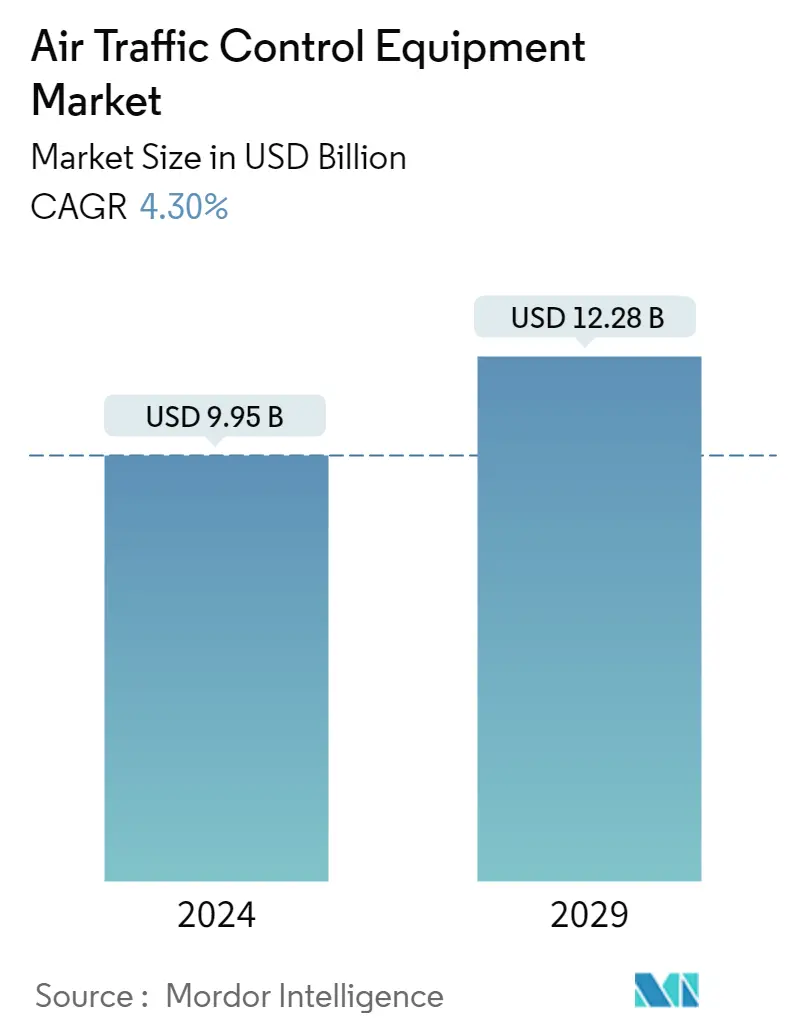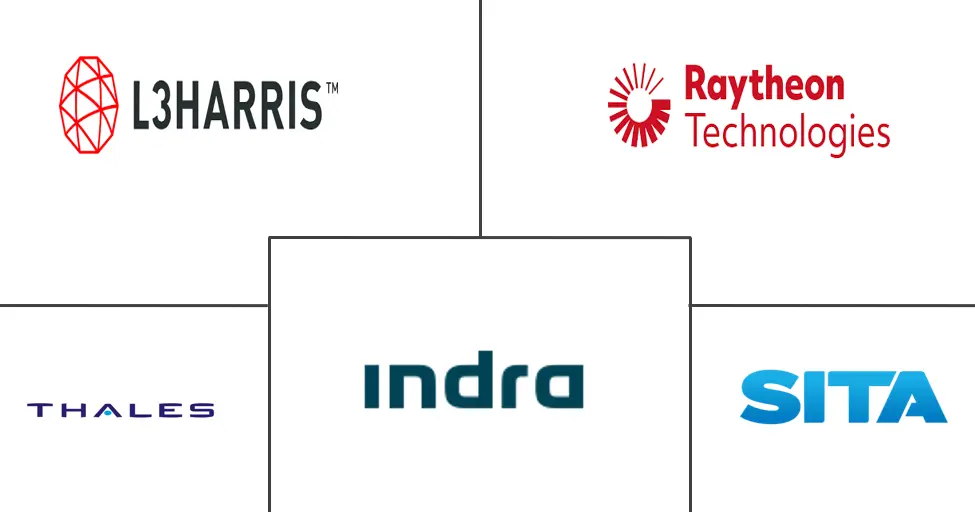
| Study Period | 2019 - 2029 |
| Base Year For Estimation | 2023 |
| Market Size (2024) | USD 9.95 Billion |
| Market Size (2029) | USD 12.28 Billion |
| CAGR (2024 - 2029) | 4.30 % |
| Fastest Growing Market | Asia-Pacific |
| Largest Market | North America |
Major Players
*Disclaimer: Major Players sorted in no particular order |
Air Traffic Control Equipment Market Analysis
The Air Traffic Control Equipment Market size is estimated at USD 9.95 billion in 2024, and is expected to reach USD 12.28 billion by 2029, growing at a CAGR of 4.30% during the forecast period (2024-2029).
During COVID-19, many countries put travel restrictions in place, which caused a significant drop in the number of people who flew. Hence the number of passengers on international routes also declined. For instance, South Korea's air passenger volume decreased by 7.7% in 2021 compared to the previous year. Japan's aviation sector also witnessed a significant impact; Narita International Airport in Tokyo saw 5.2 million passengers in 2021, 50% fewer than in 2020. Nevertheless, when international flight restrictions were lifted across most countries, air traffic gradually improved and is still growing, necessitating the demand for new automated air traffic management systems as airports look to accommodate and operate a subsequent increase in aircraft traffic daily.
The rapidly growing air passenger traffic necessitated the development of new airports to serve new routes and the modernization of existing ones to facilitate the seamless movement of aircraft operating in the airspace. Thus, an increase in the number of airports in emerging economies and the need for efficient airspace management have forced airports and airlines to invest in air traffic control technologies. For instance, Airbus, an aircraft manufacturer, forecasted that the number of commercial aircraft in operation would double in the next 20 years to 48,000 worldwide. Such developments are anticipated to trigger demand for air traffic control equipment during the forecast period.
Air Traffic Control Equipment Industry Segmentation
Air traffic control equipment keeps synchronization between aircraft and air traffic control (ATC) and helps in navigation during takeoff and landing of aircraft.
The air traffic control equipment market is segmented by end-user, type, airport type, and geography. By end user, the market is segmented into commercial and military. By type, the market is segmented into communication equipment, navigation equipment, and surveillance equipment. By airport type, the market is segmented into brownfield and greenfield. By geography, the market is segmented into North America, Europe, Asia-Pacific, Latin America, the Middle East, and Africa. The market sizing and forecasts have been provided in value (USD million) for all the above segments.
| Commercial |
| Military |
| Communication Equipment |
| Navigation Equipment |
| Surveillance Equipment |
| Brownfield |
| Greenfield |
| North America | United States |
| Canada | |
| Europe | Germany |
| United Kingdom | |
| France | |
| Rest of Europe | |
| Asia-Pacific | China |
| Japan | |
| India | |
| South Korea | |
| Rest of Asia-Pacific | |
| Latin America | Brazil |
| Mexico | |
| Rest of Latin America | |
| Middle East and Africa | United Arab Emirates |
| Saudi Arabia | |
| Egypt | |
| Rest of Middle East and Africa |
Air Traffic Control Equipment Market Size Summary
The air traffic control equipment market is poised for significant growth over the forecast period, driven by the resurgence of air travel post-COVID-19 and the increasing demand for efficient airspace management. As international flight restrictions have eased, there has been a notable recovery in air passenger traffic, prompting airports to invest in new automated air traffic management systems to handle the rising number of aircraft. This trend is further supported by the expansion of airports in emerging economies and the modernization of existing facilities to accommodate new routes. The market is characterized by a strong focus on advanced communication equipment, which is essential for managing air traffic in congested airspace. This segment is expected to experience the highest growth rate, fueled by increased spending on airport construction and the adoption of cutting-edge technologies.
The Asia-Pacific region is anticipated to be the fastest-growing market, driven by factors such as reduced airfares, increased affordability of air travel, and significant investments in airport infrastructure. The region's growth is further bolstered by free trade agreements, stringent aviation safety regulations, and ongoing airport construction projects. Notable developments include major expansion projects in China and India, which are expected to enhance airport capacities significantly. The market is moderately consolidated, with key players like THALES, SITA, L3Harris Technologies Inc., INDRA SISTEMAS, S.A., and Raytheon Technologies Corporation holding substantial shares. Strategic partnerships and joint ventures, such as those in India, are expected to strengthen market presence and drive further growth.
Air Traffic Control Equipment Market Size - Table of Contents
1. MARKET DYNAMICS
- 1.1 Market Overview
- 1.2 Market Drivers
- 1.3 Market Restraints
-
1.4 Industry Attractiveness - Porter's Five Forces Analysis
- 1.4.1 Bargaining Power of Buyers/Consumers
- 1.4.2 Bargaining Power of Suppliers
- 1.4.3 Threat of New Entrants
- 1.4.4 Threat of Substitute Products
- 1.4.5 Intensity of Competitive Rivalry
2. MARKET SEGMENTATION
-
2.1 End-User
- 2.1.1 Commercial
- 2.1.2 Military
-
2.2 Type
- 2.2.1 Communication Equipment
- 2.2.2 Navigation Equipment
- 2.2.3 Surveillance Equipment
-
2.3 Airport Type
- 2.3.1 Brownfield
- 2.3.2 Greenfield
-
2.4 Geography
- 2.4.1 North America
- 2.4.1.1 United States
- 2.4.1.2 Canada
- 2.4.2 Europe
- 2.4.2.1 Germany
- 2.4.2.2 United Kingdom
- 2.4.2.3 France
- 2.4.2.4 Rest of Europe
- 2.4.3 Asia-Pacific
- 2.4.3.1 China
- 2.4.3.2 Japan
- 2.4.3.3 India
- 2.4.3.4 South Korea
- 2.4.3.5 Rest of Asia-Pacific
- 2.4.4 Latin America
- 2.4.4.1 Brazil
- 2.4.4.2 Mexico
- 2.4.4.3 Rest of Latin America
- 2.4.5 Middle East and Africa
- 2.4.5.1 United Arab Emirates
- 2.4.5.2 Saudi Arabia
- 2.4.5.3 Egypt
- 2.4.5.4 Rest of Middle East and Africa
Air Traffic Control Equipment Market Research FAQs
How big is the Air Traffic Control Equipment Market?
The Air Traffic Control Equipment Market size is expected to reach USD 10.38 billion in 2025 and grow at a CAGR of 4.30% to reach USD 12.81 billion by 2030.
What is the current Air Traffic Control Equipment Market size?
In 2025, the Air Traffic Control Equipment Market size is expected to reach USD 10.38 billion.


